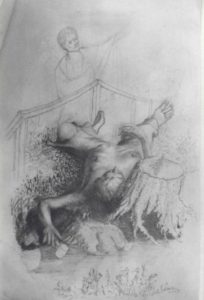1865 was a year of events and activity for Lew Wallace. Early in the year he was sent to Mexico to prevent Mexican support of the dying Confederacy. While in Mexico he learned of the end of the Civil War and the death of Abraham Lincoln.
Military Trials
Upon his return to Washington, D.C. he served on the tribunal that tried the Lincoln conspirators and he was the presiding judge of the tribunal that tried Commander Henry Wirz for war crimes. Wirz was in charge of the infamous Civil War prison camp in Andersonville, Georgia. After a two month trial, Wirz was found guilty on eleven of thirteen counts of murder and sentenced to death. On November 10, 1865, Wirz was hanged on the site that is now occupied by United States Supreme Court.

During the trial of the Lincoln conspirators, Lew Wallace made small pencil sketches to pass the time. During the Wirz trial he also spent time sketching. As the trial unfolded one story in particular haunted the general.
He heard stories of the deadline—a line within the stockade which the prisoners were forbidden to cross. Just beyond the deadline was a small stream. In gripping testimony the court heard about a prisoner of war stretching his emaciated arm toward the stream, his hand holding a tin cup. When his hand crossed the deadline, he was shot and killed by one of the Confederate prison guards.
The Deadline
Wallace sketched a vivid image of this unnamed man in tattered pants lying in the mud with his outstretched hand over the stream. This sketch survives, as does a second sketch owned by the Indiana Historical Society. We aren’t sure where to find the actual painting. (Please let us know if you’ve seen it!)
The finished deadline painting was exhibited in Chicago in 1867, in Boston in 1873 and in Indianapolis in 1878. The painting was generally praised for its boldness of conception, technical skill and somberness—although the Boston Advertiser did find it too “horribly realistic.”
In 1878 Lew gave the painting to the Terre Haute Guards. According to a letter in our files from 1963, someone in Terre Haute thought it might be at the GAR home in Lafayette. Perhaps the painting moved to an association or museum and still resides deep in a vault somewhere.
The fate of the painting and the name of the subject are both shrouded in mystery. We are, however, fortunate that the sketch survives to convey both the extent of the General’s talent and the personal side of the trauma of the Civil War still so fresh in 1865.